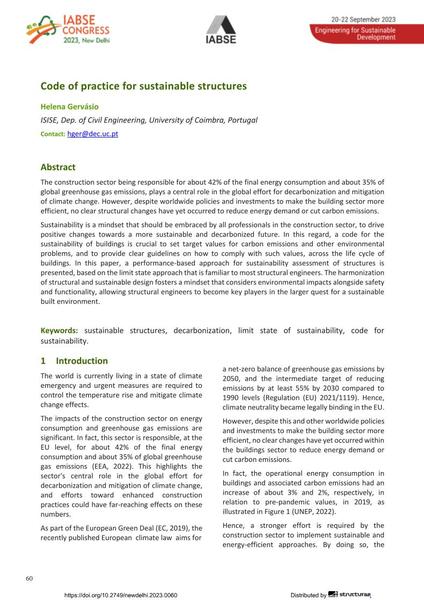Code of practice for sustainable structures

|
|
|||||||||||
Bibliografische Angaben
| Autor(en): |
Helena Gervásio
(ISISE, Dep. of Civil Engineering, University of Coimbra, Portugal)
|
||||
|---|---|---|---|---|---|
| Medium: | Tagungsbeitrag | ||||
| Sprache(n): | Englisch | ||||
| Tagung: | IABSE Congress: Engineering for Sustainable Development, New Delhi, India, 20-22 September 2023 | ||||
| Veröffentlicht in: | IABSE Congress New Delhi 2023 | ||||
|
|||||
| Seite(n): | 60-67 | ||||
| Anzahl der Seiten (im PDF): | 8 | ||||
| DOI: | 10.2749/newdelhi.2023.0060 | ||||
| Abstrakt: |
The construction sector being responsible for about 42% of the final energy consumption and about 35% of global greenhouse gas emissions, plays a central role in the global effort for decarbonization and mitigation of climate change. However, despite worldwide policies and investments to make the building sector more efficient, no clear structural changes have yet occurred to reduce energy demand or cut carbon emissions. Sustainability is a mindset that should be embraced by all professionals in the construction sector, to drive positive changes towards a more sustainable and decarbonized future. In this regard, a code for the sustainability of buildings is crucial to set target values for carbon emissions and other environmental problems, and to provide clear guidelines on how to comply with such values, across the life cycle of buildings. In this paper, a performance-based approach for sustainability assessment of structures is presented, based on the limit state approach that is familiar to most structural engineers. The harmonization of structural and sustainable design fosters a mindset that considers environmental impacts alongside safety and functionality, allowing structural engineers to become key players in the larger quest for a sustainable built environment. |
||||
